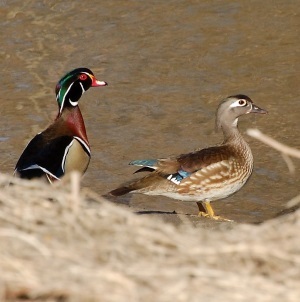With their exquisite, bright coloration, male wood ducks are considered one of the most beautiful birds in the world. In fact, their scientific name, Aix sponsa, is Latin for “promised bride,” alluding to how the drakes look dressed to attend a wedding.
Wood ducks are medium-sized ducks that frequent wooded ponds, streams and marshes. Both hens and drakes have colorful blue, maroon and silver-accented wings. The hens are much more plainly colored, with grey-brown upperparts, mottled brown and white breasts, white bellies and a white, teardrop-shaped eye patch.
Wood duck pairs nest in tree cavities that are 15-30 feet above the ground or in man-made nest boxes. The hens lay nine to 14 eggs at a time. Wood duck hens sometimes lay their eggs in the nests of other wood duck hens. This leaves one hen with more than her share of ducklings to raise. Nests have been documented with up to 40 eggs in them!
Only a few days after hatching, young wood ducks are ready to leave the nest. The mother flies to the ground and then calls to her youngsters to encourage them. The young then jump the long distance from the tree cavity to the ground. The fluffy, downy chicks bounce when they land and toddle off after their mothers without a scratch.
Young wood ducks eat invertebrates and fish but switch to a more plant-based diet in adulthood. Adult wood ducks eat aquatic vegetation and fruits and nuts they find on the forest floor. Acorns are a particular favorite.
In Michigan, wood ducks were common prior to European settlement. They rapidly decreased in number during the late 1800s due to unregulated hunting, deforestation and loss of wetland habitat. This species was believed to be in imminent danger of extinction in the late 1800s and early 1900s.
Because of the dramatic decline of wood duck populations, wood duck hunting was banned in 1915. This national hunting prohibition was lifted in 1941, and states were allowed to have limited, regulated hunting seasons. Michigan opened wood duck hunting seasons in 1944, with a bag limit of one duck. Development of artificial nest boxes in the 1930s further helped wood ducks reoccupy their former range.
Today, wood duck populations are thriving. The birds are banded each year in Michigan to help monitor their populations, and extensive wetland and forest habitat work helps to ensure these beautiful ducks have proper nesting and feeding habitat.
This Wildlife Conservation Month, you can help wood ducks by erecting wood duck boxes in your wooded wetlands. Take a look at this wood duck box plan from Ducks Unlimited and install one to help the wood ducks near you!


